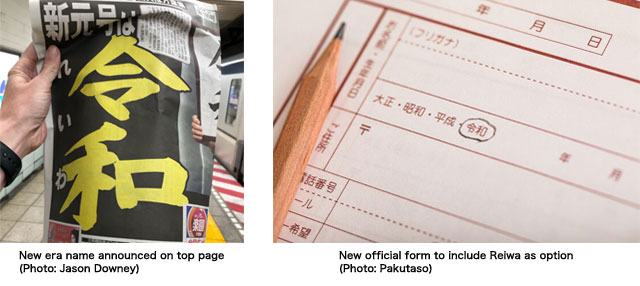News
May - Reiwa: A New Era Begins in Japan Updated in May 2019
Welcome to a new era in Japanese history! The new era name Reiwa (令和) was announced on April 1st, 2019, to follow the Heisei era (平成 1989-2019). The Reiwa era officially began on May 1st when the new emperor reigned.
You may have heard about this, but what does it mean? Why does Japan have two calendars? And how is the era and the emperor connected?
Japan adopted its year-naming custom from China in the mid-7th century, and it’s been in constant use ever since. In Japanese, the era system is known as nengō (年号) or gengō (元号).
These days, the name of the current era is linked to the reigning emperor. Historically, however, this was not the case. The name of an era could change for several reasons — the Wadō (和銅) era began in 708 to commemorate the discovery of Japan’s first copper mine; the Genna (元和) era began in 1615, immediately after all the nationwide battles ceased. Other reasons an era could begin or end include arrival of comets, natural disasters, plagues, inauspicious (unlucky) years, or even combinations of events. By adopting a new era name, ancient rulers wanted to “reset” history to a fresh start.
This custom changed in 1868 when the Imperial Household Law declared that an emperor’s reign and the era name should be linked. From Meiji Period (1868-1912) onward, the name of an era would continue for as long as the emperor remained on the throne. As a result of this, when reigning emperors passed away, they adopted the era name he ruled. e.g. The Meiji Emperor, the Taisho Emperor and the Showa Emperor. The recently retired Emperor Akihito is an exception. An abdicated or retired emperor is called Jōkō (上皇Emperor Emeritus).
In modern Japan, the gengō calendar is used side-by-side with the standard Gregorian calendar used around the world. Japanese era-years are often used on official forms and contracts, in newspapers, and on driver’s licenses. In this system, Tokyo Tower was completed in Shōwa 33 (1958), Pokémon debuted in Heisei 8 (1996), and the 2020 Tokyo Olympics will take place in Reiwa 2. Note: Showa means “bright peace” while Heisei roughly translates into “peace everywhere.”
The name announced by the prime minister’s cabinet on April 1st began a new tradition in Japanese history. The name “Reiwa” was created from a mid-8th-century book of Japanese poetry, Man’yōshū (The Book of Ten-Thousand Leaves). Until now for over 1000 years, each era name came from Chinese classical books like “I Ching” and “Shangshu” (the Book of Documents). The prime minister said that drawing the name from this particular book with a Japanese origin was important because Man’yōshū includes poetry and songs by farmers and low-ranking officials, not just members of the nobility. He said he hoped the name would offer a sense of unity to the people of Japan.
The two characters, 令 and 和, come from an introduction to the section of Man’yōshū dedicated to plum blossoms. These flowers are a sign of spring in east Asian culture because they typically bloom in February and March. The character 令 roughly translates as “auspicious”, and the character 和 as “harmony”. On April 2nd, the government announced that “Reiwa” officially means “beautiful harmony” in English.
So, this month, join us in celebrating a new era in Japanese history — the Reiwa Era.








